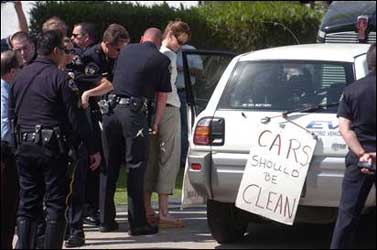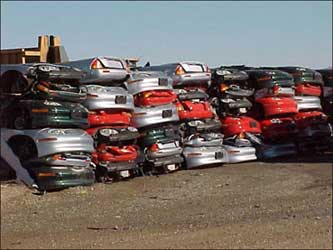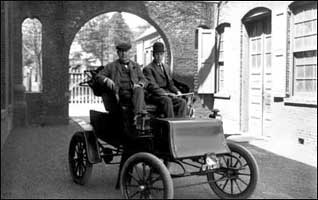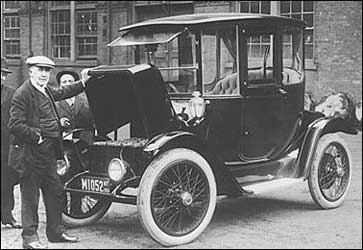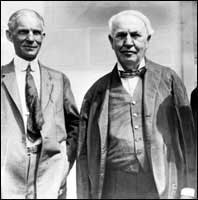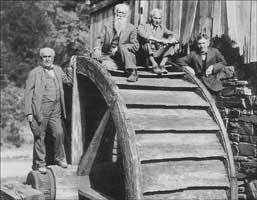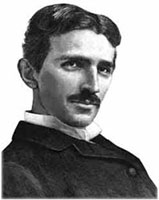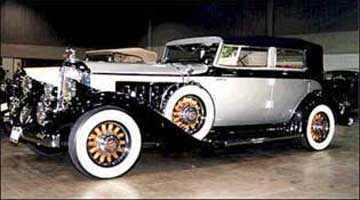| Who Killed the Electric Car? |
This
exposé is under construction |
Click
on images to enlarge |
|
Running solely on electricity, General Motor's fleet of EV1 electric vehicles were so efficient that they were on the brink of altering the future of driving in the U.S. —perhaps even in the entire world. Everyone who drove the cars gave them outstanding reviews.
Here is a GREAT DVD made in Hollywood about the murder of the electric car.... Most of the movies produced by Hollywood are just SMOKESCREENS to keep the citizens occupied until their liberties are subverted....Who Killed the Electric Car is a major exception.
|
Arrest of an EV1 lover. Her only CRIME was that she LOVED the non-polluting car!! |
Desperate men will do desperate things. The woman on the left was arrested for driving an electric car. The electric cars on the left had a pressing engagement—at the junkyard. |
By 1900 most cars were electric
By 1900 there were great advances in electrical technology. In the Battle of the Currents, Nicola's Teslas AC system had triumphed over Edison's DC electric current. George Westinghouse, using the Tesla system, electrified Niagara Falls and electricity was made available to all the people via long distance transmission.
|
Thomas Edison and his son Chase in electric car, circa 1914. |
|
The Ford Motor Company was a subsidiary of the Standard Oil Company!!
In 1908, Henry Ford began mass production of the infamous gasoline air polluting car known as the Model T. Most people in the U.S. believed that automobiles would be powered by the newly developed wonder of ELECTRICITY. What most people did not realize was that Ford Motor Company was a SUBSIDIARY of the Rockefeller owned Standard Oil Company.
When the other car companies saw the vast profits that Ford was making on his gasoline powered Model T, they abandoned the electric car and began to produce their own air polluting cars.
In the early 20th century, National City Lines, which was a partnership of General Motors, Firestone, and Standard Oil of California, purchased many electric tram networks across the country to dismantle them and replace them with GM buses. The partnership was convicted for this conspiracy, but the ruling was overturned in a higher court. Electric tram line technologies could be used to recharge BEVs and PHEVs on the highway while the user drives, providing virtually unrestricted driving range.
"Mr. Electric" Thomas Edison ENCOURAGED Ford to produce gasoline powered vehicles!!
Thomas Alva Edison is a revered icon in the U.S. and around the world. Many credit him with developing electricity and lighting up the world. What is very strange however is that he encouraged Henry Ford in the development of the gasoline engine. As a matter of fact, Edison and Ford were very good friends for all of their adult lives.
|
Henry Ford and Thomas Edison became very close friends. |
Edison is credited with all sorts of inventions but the ONLY thing he really invented was the electric chair. He invented that diabolical apparatus to prove that alternating current was KILLER current. |
Thomas Edison, John Burroughs, Henry Ford and Harvey Firestone on a camping expedition in 1918. |
Ford looked on Edison as a sort of demigod. He finally got to meet his hero at a convention in Atlantic City, New Jersey, in 1887. Here is Ford's own account of their first meeting:
No man exceeds Thomas A. Edison in broad vision and understanding. I met him first many years ago when I was with the Detroit Edison Company, —probably about 1887 or thereabouts. The electrical men held a convention at Atlantic City, and Edison, as the leader in electrical science, made an address. I was then working on my gasoline engine, and most people, including all of my associates in the electrical company, had taken pains to tell me that time spent on a gasoline engine was time wasted—that the power of the future was to be electricity. These criticisms had not made any impression on me. I was working ahead with all my might. But being in the same room with Edison suggested to me that it would be a good idea to find out if the master of electricity thought it was going to be the only power in the future. So, after Mr. Edison had finished his address, I managed to catch him alone for a moment. I told him what I was working on. At once he was interested. He is interested in every search for new knowledge. And then I asked him if he thought that there was a future for the internal combustion engine. He answered something in this fashion. (Ford, My Life and Work, p. 234).
Here is Edison's reply to the future of the gasoline engine:
Yes, there is a big future for any light-weight engine, that can develop a high horsepower and be self-contained. No one kind of motive power is ever going to do all the work of the country. We do not know what electricity can do, but I take for granted that it cannot do everything. Keep on with your engine. If you can get what you are after, I can see a great future. (Ford, My Life and Work, pp. 234-235).
Nikola Tesla's electric car
After the AC induction motor, the greatest invention of Nikola Tesla was the electric car. This was no ordinary battery driven car because this car took its power from the ether, just like an automobile antenna picks up radio waves from the ether.
|
In 1931, under the financing of Pierce-Arrow and George Westinghouse, a 1931 Pierce-Arrow was selected to be tested at the factory grounds in Buffalo, New York. The standard internal combustion engine was removed and an 80-H.P. 1800 r.p.m. electric motor installed to the clutch and transmission. The AC motor measured 40 inches long and 30 inches in diameter and the power leads were left standing in the air —no external power source and no recharging of any batteries was necessary.
At the appointed time, Nikola Tesla arrived from New York City and inspected the Pierce-Arrow automobile. He then went to a local radio store and purchased a handful of tubes (12), wires and assorted resistors. A box measuring 24 inches long, 12 inches wide and 6 inches high was assembled housing the circuit. The box was placed on the front seat and had its wires connected to the air-cooled, brushless motor. Two rods 1/4" in diameter stuck out of the box about 3" in length.
Mr. Tesla got into the driver's seat, pushed the two rods in and stated, "We now have power". He put the car into gear and it moved forward! This vehicle, powered by an AC motor, was driven to speeds of 90 m.p.h. and performed better than any internal combustion engine of its day! One week was spent testing the vehicle. Several newspapers in Buffalo reported this test. When asked where the power came from, Tesla replied, "From the ether all around us".
Here is a report of the incident from Tesla biographer Marc J. Seifer:
The car [was] a standard Pierce Arrow, with the engine removed and certain other components installed instead. The standard clutch, gear box, and drive train remained.... Under the hood, there was a brushless electric motor, connected to [or in place of] the engine.... Tesla would not divulge who made the motor.
Set into the dash was a "power receiver" consisting of a box ... containing 12 radio tubes.... A vertical antenna, consisting of a 6 ft. rod, was installed and connected to the power receiver [which was] in turn, connected to the motor by two heavy, conspicuous cables.... Tesla pushed these in before starting and said: "We now have power."
If this tale is to be believed, it would mean that Tesla had also installed one of his powerful oscillators somewhere near Niagara Falls to provide the wireless energy needed to power the vehicle. (Seifer, Wizard. The Life and Times of Nikola Tesla, p. 419).
Vital links
Who Killed the Electric Car? is available at most public libraries in the U.S. and from Amazon.com
References
Ford, Henry. My Life and Work. Doubleday, Page & Co., Garden City, NY, 1922.
Shnayerson, Michael. The Car That Could. The Inside Story of GM's Revolutionary Electric Vehicle. Random House, New York, 1996.
Seifer, Marc J. Wizard. The Life and Times of Nikola Tesla. Biography of a Genius. Carol Publishing Group, Secacaus, NJ, 1996.
Copyright © 2009 by Niall Kilkenny


